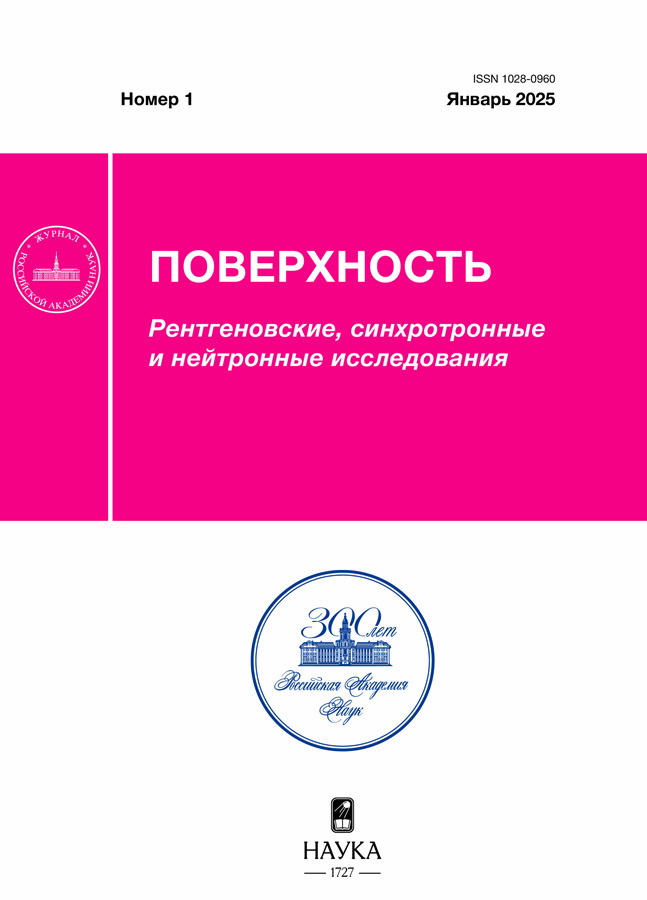Wave Functions of Positrons Channeling in [111] Direction of a Silicon Crystal
- 作者: Syshchenko V.V.1, Tarnovsky A.I.1, Parakhin A.S.1, Isupov A.Y.2
-
隶属关系:
- Belgorod State University
- Laboratory of High Energy Physics, Joint Institute for Nuclear Research
- 期: 编号 1 (2025)
- 页面: 125-134
- 栏目: Articles
- URL: https://rjsocmed.com/1028-0960/article/view/686112
- DOI: https://doi.org/10.31857/S1028096025010173
- EDN: https://elibrary.ru/CNAQTA
- ID: 686112
如何引用文章
详细
For a positively charged particle, the repulsive uniform potentials of the three neighboring [111] chains of the silicon crystal form a small potential well with the symmetry of an equilateral triangle is described by the C3v group. The motion of a quantum particle in such a well is of interest in terms of manifestations of quantum chaos. A previously developed procedure for numerically finding the energy levels and wave functions of stationary states, taking into account the symmetry of this problem, is used to study the transverse motion of the channeling positrons with energies of 5, 6 and 20 GeV. A classification of stationary states of transverse motion of a positron is given based on the theory of group representations. The wave functions of the stationary states in an axially symmetric potential well are also found, and it is shown how these functions are modified under the influence of a perturbation with the symmetry of an equilateral triangle. In the upper part of the triangular potential well, the classical motion is chaotic for the majority of initial conditions. The structure of the wave functions in this domain has the features predicted by the quantum chaos theory.
全文:
作者简介
V. Syshchenko
Belgorod State University
编辑信件的主要联系方式.
Email: syshch@yandex.ru
俄罗斯联邦, Belgorod, 308015
A. Tarnovsky
Belgorod State University
Email: syshch@yandex.ru
俄罗斯联邦, Belgorod, 308015
A. Parakhin
Belgorod State University
Email: syshch@yandex.ru
俄罗斯联邦, Belgorod, 308015
A. Isupov
Laboratory of High Energy Physics, Joint Institute for Nuclear Research
Email: syshch@yandex.ru
俄罗斯联邦, Dubna, 141980
参考
- Ахиезер А.И., Шульга Н.Ф. Электродинамика высоких энергий в веществе. М.: Наука, 1993. 344 с.
- Ахиезер А.И., Шульга Н.Ф., Трутень В.И., Гриненко А.А., Сыщенко В.В. // УФН. 1995. Т. 165. № 10. С. 1165. https://doi.org/10.3367/UFNr.0165.199510c.1165
- Gemmel D.S. // Rev. Mod. Phys. 1974. V. 46. P. 129. https://doi.org/10.1103/RevModPhys.46.129
- Uggerhøj U.I. // Rev. Mod. Phys. 2005. V. 77. P. 1131. https://doi.org/10.1103/RevModPhys.77.1131
- Lindhard J. // Kongel. Dan. Vidensk. Selsk., Mat.-Fys. Medd. 1965. V. 34 (14). P. 1.
- Шульга Н.Ф., Сыщенко В.В., Тарновский А.И., Исупов А.Ю. // Поверхность. Рентген., синхротр. и нейтрон. исслед. 2015. № 7. С. 72. https://doi.org/10.7868/S0207352815070197
- Shul’ga N.F., Syshchenko V.V., Tarnovsky A.I., Isupov A.Yu. // Nucl. Instrum. Methods Phys. Res. B. 2016. V. 370. P. 1. https://doi.org/10.1016/j.nimb.2015.12.040
- Shul’ga N.F., Syshchenko V.V., Tarnovsky A.I., Isupov A.Yu. // J. Phys.: Conf. Ser. 2016. V. 732. P. 012028. https://doi.org/10.1088/1742-6596/732/1/012028
- Шульга Н.Ф., Сыщенко В.В., Тарновский А.И., Исупов А.Ю. // Поверхность. Рентген., синхротр. и нейтрон. исслед. 2016. № 4. С. 103. https://doi.org/10.7868/S0207352816040168
- Сыщенко В.В., Тарновский А.И. // Поверхность. Рентген., синхротр. и нейтрон. исслед. 2021. № 7. С. 84. https://doi.org/10.31857/S1028096021070207
- Сыщенко В.В., Тарновский А.И., Исупов А.Ю., Соловьев И.И. // Поверхность. Рентген., синхротр. и нейтрон. исслед. 2020. № 3. С. 103. https://doi.org/10.31857/S1028096020030188
- Shul’ga N.F., Syshchenko V.V., Tarnovsky A.I., Dronik V.I., Isupov A.Yu. // J. Instrum. 2019. V. 14. P. C12022. https://doi.org/10.1088/1748-0221/14/12/C12022
- Сыщенко В.В., Тарновский А.И., Дроник В.И, Исупов А.Ю. // Поверхность. Рентген., синхротр. и нейтрон. исслед. 2022. № 3. С. 79. https://doi.org/10.31857/S1028096022030207
- Сыщенко В.В., Тарновский А.И., Дроник В.И, Исупов А.Ю. // Поверхность. Рентген., синхротр. и нейтрон. исслед. 2023. № 6. С. 88. https://doi.org/10.31857/S1028096023060158
- Ландау Л.Д., Лифшиц Е.М. Теоретическая физика. Т. 3. Квантовая механика. Нерелятивистская теория. М.: Физматлит, 2016. 800 с.
- Gutzwiller M.C. Chaos in Classical and Quantum Mechanics. Springer, 1990. https://doi.org/10.1007/978-1-4612-0983-6
- Штокман Х.-Ю. Квантовый хаос. М.: Физматлит, 2004. 376 с.
- Райхл Л.Е. Переход к хаосу в консервативных классических и квантовых системах. М.–Ижевск: РХД, 2008. 756 с.
- Bolotin Y., Tur A., Yanovsky V. Chaos: Concepts, Control and Constructive Use. Springer International Publishing Switzerland, 2017. 281 p. https://doi.org/10.1007/978-3-319-42496-5
- Hénon M., Heiles C. // Astronom. J. 1964. V. 69. P. 73. https://doi.org/10.1086/109234
- Davis M.J., Heller E.J. // J. Chem. Phys. 1981. V. 75. P. 246. https://doi.org/10.1063/1.441832
- Syshchenko V.V., Tarnovsky A.I., Parakhin A.S., Isupov A.Yu. // J. Surf. Invest.: X-ray, Synchrotron Neutron Tech. 2024. V. 18. № 2. P. 274. https://doi.org/ 10.1134/S1027451024020186
- Feit M.D., Fleck J.A., Jr., Steiger A. // J. Comput. Phys. 1982. V. 47. P. 412. https://doi.org/10.1016/0021-9991(82)90091-2
- Шульга Н.Ф., Сыщенко В.В., Нерябова В.С. // Поверхность. Рентген., синхротр. и нейтрон. исслед. 2013. № 3. С. 91. https://doi.org/10.1134/S1027451013020183
- Shul’ga N.F., Syshchenko V.V., Neryabova V.S. // Nucl. Instrum. Methods Phys. Res. B. 2013. V. 309. P. 153. https://doi.org/10.1016/j.nimb.2013.01.022
- Галицкий В.М., Карнаков Б.М., Коган В.И. Задачи по квантовой механике. М.: Наука, 1981. 648 с.
- Шапиро Д.А. Представления групп и их применения в физике. Новосибирск: НГУ, 2005. 142 с.
- Исупов А.Ю., Сыщенко В.В., Парахин А.С. // Прикладная математика & физика. 2023. Т. 55. № 1. С. 49. https://doi.org/ 10.52575/2687-0959-2023-55-1-49-56
- Исупов А.Ю., Сыщенко В.В., Тарновский А.И., Парахин А.С. // Прикладная математика & физика. 2024. Т. 56, № 4. С. 320. https://doi.org/10.52575/2687-0959-2024-56-4-320-327
补充文件
















